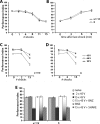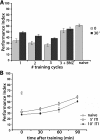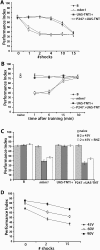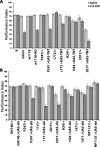Protection from premature habituation requires functional mushroom bodies in Drosophila
- PMID: 17522029
- PMCID: PMC1876762
- DOI: 10.1101/lm.566007
Protection from premature habituation requires functional mushroom bodies in Drosophila
Abstract
Diminished responses to stimuli defined as habituation can serve as a gating mechanism for repetitive environmental cues with little predictive value and importance. We demonstrate that wild-type animals diminish their responses to electric shock stimuli with properties characteristic of short- and long-term habituation. We used spatially restricted abrogation of neurotransmission to identify brain areas involved in this behavioral response. We find that the mushroom bodies and, in particular, the alpha/beta lobes appear to guard against habituating prematurely to repetitive electric shock stimuli. In addition to protection from premature habituation, the mushroom bodies are essential for spontaneous recovery and dishabituation. These results reveal a novel modulatory role of the mushroom bodies on responses to repetitive stimuli in agreement with and complementary to their established roles in olfactory learning and memory.
Figures





Similar articles
-
Drosophila Bruton's Tyrosine Kinase Regulates Habituation Latency and Facilitation in Distinct Mushroom Body Neurons.J Neurosci. 2019 Oct 30;39(44):8730-8743. doi: 10.1523/JNEUROSCI.0633-19.2019. Epub 2019 Sep 17. J Neurosci. 2019. PMID: 31530645 Free PMC article.
-
Localization of long-term memory within the Drosophila mushroom body.Science. 2001 Nov 2;294(5544):1115-7. doi: 10.1126/science.1064200. Science. 2001. PMID: 11691997
-
Distinct neuronal circuits mediate experience-dependent, non-associative osmotactic responses in Drosophila.Mol Cell Neurosci. 2007 Mar;34(3):378-89. doi: 10.1016/j.mcn.2006.11.011. Epub 2007 Jan 2. Mol Cell Neurosci. 2007. PMID: 17197197
-
Learning and memory in Drosophila: behavior, genetics, and neural systems.Int Rev Neurobiol. 2011;99:139-67. doi: 10.1016/B978-0-12-387003-2.00006-9. Int Rev Neurobiol. 2011. PMID: 21906539 Review.
-
Are mushroom bodies cerebellum-like structures?Arthropod Struct Dev. 2011 Jul;40(4):368-79. doi: 10.1016/j.asd.2011.02.004. Epub 2011 Mar 1. Arthropod Struct Dev. 2011. PMID: 21371566 Review.
Cited by
-
The Two Cysteines of Tau Protein Are Functionally Distinct and Contribute Differentially to Its Pathogenicity in Vivo.J Neurosci. 2021 Jan 27;41(4):797-810. doi: 10.1523/JNEUROSCI.1920-20.2020. Epub 2020 Dec 17. J Neurosci. 2021. PMID: 33334867 Free PMC article.
-
Drosophila Tau Negatively Regulates Translation and Olfactory Long-Term Memory, But Facilitates Footshock Habituation and Cytoskeletal Homeostasis.J Neurosci. 2019 Oct 16;39(42):8315-8329. doi: 10.1523/JNEUROSCI.0391-19.2019. Epub 2019 Sep 5. J Neurosci. 2019. PMID: 31488613 Free PMC article.
-
Habituation Learning Is a Widely Affected Mechanism in Drosophila Models of Intellectual Disability and Autism Spectrum Disorders.Biol Psychiatry. 2019 Aug 15;86(4):294-305. doi: 10.1016/j.biopsych.2019.04.029. Epub 2019 May 9. Biol Psychiatry. 2019. PMID: 31272685 Free PMC article.
-
Appetitive and aversive visual learning in freely moving Drosophila.Front Behav Neurosci. 2010 Mar 9;4:10. doi: 10.3389/fnbeh.2010.00010. eCollection 2010. Front Behav Neurosci. 2010. PMID: 20300462 Free PMC article.
-
Differential Effects of Human Tau Isoforms to Neuronal Dysfunction and Toxicity in the Drosophila CNS.Int J Mol Sci. 2022 Oct 26;23(21):12985. doi: 10.3390/ijms232112985. Int J Mol Sci. 2022. PMID: 36361774 Free PMC article.
References
-
- Acevedo S.F. “The dynamics, interactions and phenotypes associated with the three members of the 14–3–3 family in Drosophila melanogaster”. Ph.D. thesis, Texas A&M University, College Station, TX 2004
-
- Acevedo S.F., Froudarakis E.I., Tsiorva A.A., Skoulakis E.M.C. Distinct neuronal circuits mediate experience-dependent, non-associative osmotactic responses in Drosophila. Mol. Cell. Neurosci. 2007;34:378–389. - PubMed
-
- Adler L.E., Freedman R., Ross R.G., Olincy A., Waldo M. Elementary phenotypes in the neurobiological and genetic study of schizophrenia. Biol. Psychiatry. 1999;46:8–18. - PubMed
Publication types
MeSH terms
LinkOut - more resources
Full Text Sources
Molecular Biology Databases
